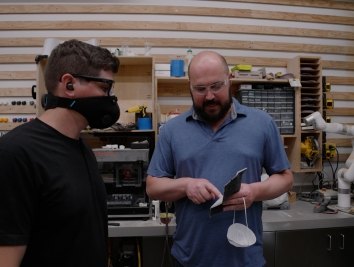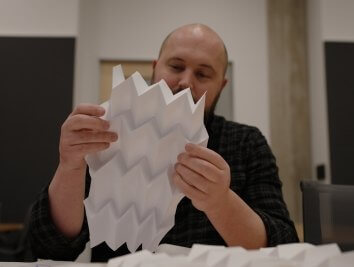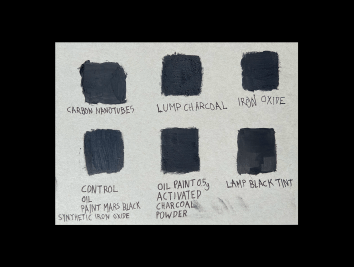Corgan Create: Sustainable Action Initiative
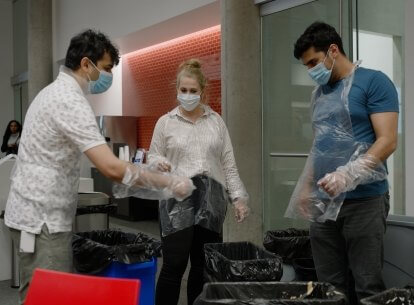
When Corgan Create kicked off in 2014, it was a natural extension of the firm’s spirit of agility and innovation. Supporting the curiosity of individuals who want to explore emerging technologies, design methodologies, or any “big idea” they are passionate about has led to an array of projects with real design applications. That even off-duty Corgan employees favor human-centric, user-experience focused projects isn’t surprising, but it is rewarding to see the genuine passion for Corgan’s ethos beyond the job description.
Just as in years past, the 2023 finalists showcased their innovation, determination, and imagination during the first Create event since the pandemic. Here is one of the three finalists:
Sustainable Action Initiative
Unmesh Kelkar, Mahdi Afkhami, and Dana Wellman teamed up for the Sustainable Action Initiative to create a simple, intuitive plan to reduce the Dallas office’s workplace waste to near nothing. After hearing from Dallas employees, the team realized they needed more data – and to revamp their original plan. They persevered, regrouped, and dug through a ton of garbage after three separate work lunches. The result? They found that around three-quarters of the Dallas office’s waste can be composted, they then contracted with Turn to bring composting to the office. They also plan to replace single-use items (like plasticware or plastic bags) with reusable items, eliminate the default to single-use water bottles in meetings, and find a recycle partner for other office waste and e-waste. Since one of the major roadblocks to recycling was awareness and messaging, the team is working with the facilities, branded environment, and change management teams at Corgan to create consistent messaging around waste management. The team plans to scale their initiative to Corgan offices across the globe.
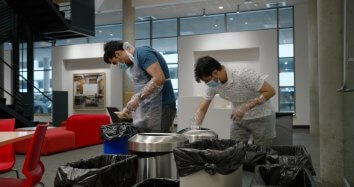
Q&A
What was the spark? What made you think “I should see what would happen if…”?
Waste management and reduction play a pivotal role in formulating a comprehensive sustainability action plan. Mitigating landfill contributions yields a myriad of advantages, including the alleviation of health concerns, a reduction in CO2 emissions, and the promotion of cleaner water.
How did you simplify your “big idea” into a doable project? Were there any difficulties?
Initially, our focus was on comprehending user reactions and identifying their input and needs. This led us to conduct surveys in distinct steps, allowing us to gather comprehensive data and make informed, data-driven decisions. Simultaneously, we engaged with the sustainability initiative team to strategize the most effective approach for preventing organic waste from reaching landfills. This collaborative effort ensured a holistic understanding of user perspectives and enabled us to tailor our initiatives for maximum impact.
What is/was the vision, ideally?
At first, the idea was to have breakroom waste sorting bins (recycle, landfill, organic) in one spot. However, with the current roadmap the vision is to not only eliminate the organic waste going to landfill, but also getting rid of any single use cutlery and hopefully banning all single use plastic bottles.
What is the next step, practically?
In this work, we tackled mostly organic waste and aiming for increasing the reuse culture in the office. Next steps would be creating more comprehensive waste reduction in other areas such as installing beverage dispensers to replace single use beverages. Working with food suppliers, distributors, and vendors to prevent waste before it happens.
How will you know when the project is successful?
To evaluate the impact and effectiveness of our waste reduction project, it is imperative to establish key performance indicators (KPIs). One crucial metric involves quantifying the organic waste diverted from our landfill through the utilization of a new vendor. Simultaneously, we should assess the resulting reduction in the project's carbon footprint associated with waste management activities.
Another vital aspect to consider is the waste reduction rate achieved through the adoption of reusable items. For instance, we can calculate the decrease in single-use cutlery destined for landfills each month by implementing reusable alternatives.
Additionally, it is essential to gauge employee engagement in the implemented programs as a significant factor in the project's success. Monitoring these KPIs collectively will provide a comprehensive understanding of the project's achievements and areas for potential improvement.





